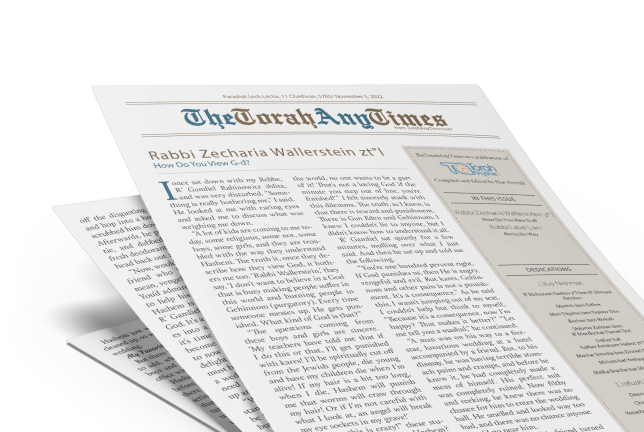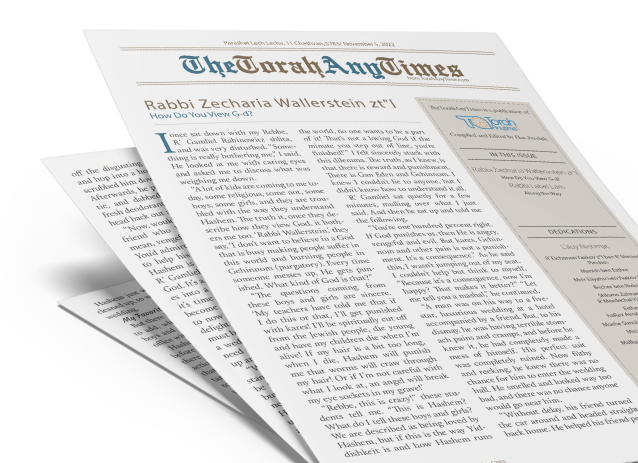|
Rabbi Eytan Feiner
Our Fingers and the Four Exiles
The Ben Ish Chai (Parshas Ki Savo) fascinatingly writes that the four fingers of the hand correspond to the four malchiyos (kingships) that the Jewish people have been subjected to – Egypt, Babylon, Persia/Greece and Rome. The thumb, however, which stands alone from the other four fingers is the finger which alludes to the Jews, reminiscent of the Pasuk describing us, “A nation which dwells in solitude” (Bamidbar 23:9). What exactly is the meaning behind this allusion?
All the other nations of the world have a special sar, angel, which serves as their intermediary between themselves and Hashem. The Jewish nation, in contrast, shares a direct connection and communication with Hashem. The other nations are thus alluded to with the other four fingers which have three joints, a top, middle and bottom. In essence, there is an intervening space in the middle, similar to the intermediary which they must rely on and relate to before reaching Hashem. In contrast, the thumb has no such middle joint. The two joints are directly one above the other. This represents the Jewish people who do not need to rely on any other external force to connect to Hashem.
This is in fact why, explains Rav Samson Raphael Hirsch, the thumb is called the godal, a word short for agudal and similarly cognate to the word agudah, which signifies a unified and joined group. It is the thumb which faces all the other fingers and has the advantageous maneuverability to wrap itself around all the other fingers and join them together.1
The thumb, adds the Ben Ish Chai, has the capability of rising above all the other fingers or sinking below. When the Jewish nation, as represented by the thumb, is following the will and ways of Hashem, it rises above the other nations, as per the verse in Parshas Ki Savo, “והיה אם שמוע תשמע בקול ד' אלקיך...ונתנך ד' אלקיך עליון על כל גויי הארץ – And it will be if you listen to the voice of Hashem… Hashem will place you above all the nations of the world” (Devarim 28:1).
In this vein, the word עליון (lit. above) is not coincidentally a contraction of the words על יון – over Yavan (Greece). When we live according to the will of G-d, we hold the capability of rising above Yavan and subjugating them. What, though, does this really mean?
As the Maharal, Vilna Gaon and Rav Tzadok write, the way to discover the true, underlying meaning of a word or phrase is by looking to its first appearance in the Torah. And what is the first indication of the word Elyon in the Torah? In Parshas Lech Lecha(14:18), Malki-Tzedek, king of Jerusalem, is depicted as the “Kohen Le-l Elyon.” Malki-Tzedek, who was in fact Shem (son of Noach), was the first Kohen Gadol (Nedarim 32b). And it was his descendants, the house of the Chashmonaim (Maccabees), who were Kohanim and were עליון – על יון.
The Maharal further observes that Yavan, whose gematria (numerical value) is 66, was able to contaminate the oil which was in the Heichal, or Sanctuary, (gematria 65) of the Beis Hamikdash. Yavan had just a slight upper-hand advantage over the Heichal and was thus able to exercise their dominion over it. However, a Kohen, whose gematria is 75 and ten more than that of Heichal, functions as the one who connects the Heichal to a higher dimension of kedusha.2 Yavan can thus only penetrate into the Heichal; but the Kohen can enter even further, into the Kodesh Hakodashim, the Holy of Holies. Yavan can as well contaminate all the jars of oil, except the one which has the seal of the Kohen.
Along these lines, the Rabbeinu Bachye (Parshas Tzav, 8:23) cites the Chachmei HaTeva who explain that man’s five fingers correspond to his five senses.3 Hashem provided man with five fingers and each finger knows to instinctively serve one of the five senses. Thus, for instance, when one wishes to remove food from their mouth, it is the thumb which is typically used to do so. As well, have you ever wondered why babies specifically suck their thumbs? Why not their pinkies? It is because the thumb corresponds to the mouth and sense of taste. Why as well do we clean out our nose with the etzbah, the second finger? It is because the second finger relates to the chush ha’reyach, sense of smell. The amah, third finger (Kesubos 5a), is the longest and thus used to reach far parts of the body to alleviate an itch or pain. It corresponds to the sense of touch. The fourth finger, known as the kemitzah, relates to the sense of sight, for with it one cleans out his eyes. Although, some may use the second or third finger to accomplish this job, that is not problematic, as Rashi (Kesubos 5a) tells us that the Kohen used to be begin the kemitzah, the process of cupping the flour of a korban in his hands, beginning with the second finger. And lastly, the pinky relates to the chush of shmiah, hearing. It is the pinky, the smallest of fingers, which is used to clean out the wax from one’s ears.4
As such, the aforementioned correlation between the four malchiyos and the four fingers fits perfectly with the correspondence between the five fingers and five senses. The five fingers in order respectively relate to the Jewish people (thumb), Egypt (index finger), Babylon (middle finger), Persia/Greece (fourth finger) and Rome (pinky). As per the Midrash (Bereishis Rabbah 2:4), the Greeks’ objective was to “החשיכה עיניהם של ישראל בגזרותיהן,” to darken the “eyes” of the Jewish people with harsh decrees. Yavan, corresponding to the fourth finger, which relates to the sense of sight, strove to dim the eyes of Jews. However, the Jews, once again as the thumb, hold the capability of rising above – על יון – and reinstating the light and glory of the Beis Hamikdash and Jewish nation.
___________________________________________________
1. Parenthetically, perhaps this is why the word Agudah is spelled as it is. The Maharal writes that the letter aleph refers to singularity and unity, while beis refers to ribui, the proliferation and increase of something. This is why the Torah begins with the letter beis, for it represents the expansion of creation and the world. In fact, explains the Maharal (Netzach Yisroel, beg. Ch. 5), the word for locust – arbeh – is such for they are the only species in which has no leader. Shlomo Hamelech in Mishlei (30:27) tells us, “Melech ein la’arbeh – There is no king to the locust.” In contrast to a flock of geese or the like which has a leader, locust move in chaos and frenzy. There is no direction of leadership. There is no melech, king, which guides and directs all of the nation (the letters of melech spelled backwards are ‘kulam,’ everybody. The function of the king is to gather together his entire nation and lead them). Arbeh, writes the Maharal, are without any leader and are just a function of ribui, unrestrained increase. As such, the word Agudah is spelled aleph and then – skipping the letter beis which represents disparate increase – gimmel, (vav), daled, hei. Going through the first five letters of the Aleph-Beis, while skipping the letter beis, an Agudah is created from those letters which speak to a unified cohesiveness and oneness. Hence, the word Agudah, unmistakably missing the letter beis.
2. The letter yud, whose numerical value is ten, always represents holiness, as we find throughout the Torah – 10 Makkos, 10 Commandments, 10 Utterances which created the world. See Menachos 29b which states that the World to Come was created using the letter yud.
3. Although Aristotle and other scientists contend that there are 29 senses, they have their roots and can be traced back to these most basic five senses.
4. See John Lloyd and John Mitchinson in 1,339 Interesting Facts that will make your jaw drop (New York: Crown, 2010, p. 177) who corroborate that Anglo-Saxons used to call the pinky the “ear finger” because it was in fact used to clean out the wax from one’s ear.
|




